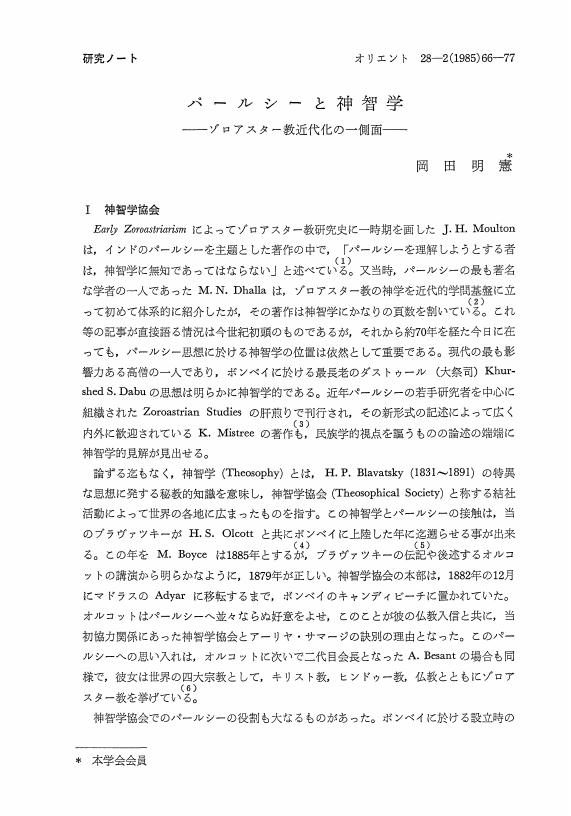7 0 0 0 OA ゾロアスター教の大女神 -Armaiti, Aši, Anahita
- 著者
- 岡田 明憲
- 出版者
- 一般社団法人 日本オリエント学会
- 雑誌
- オリエント (ISSN:00305219)
- 巻号頁・発行日
- vol.39, no.1, pp.85-99, 1996-09-30 (Released:2010-03-12)
A variety of goddesses appear in the Zoroastrian pantheon. Among them, three goddesses are especially significant -Armaiti, Aši, and Anahita.Armaiti is a member of the Ameša Spentas and is ranked among the highest order of goddesses. Aši is closely connected with the concept of Aša, the core of the thought of Zoroaster himself. In Yašt it is recorded that Aši was the love of Zoroaster. Anahita, apparently influenced by the cult of Mesopotamian Mother Goddess, became the most popular object of Iranian faith.The three goddesses have separate origins and are theologicaly distinct. Nonetheless, under the influence of Indo-Iranian folk beliefs, all these goddesses have been viewed as the Earth Mother and as the complements to deities of the sky. Ahura Mazda and Armaiti were regarded as the parents of Gaya Maretan, or the primeval man. Mi∂ra and Anahita formed a pair. Aši was closely associated with Sraoša. These models parallel the dual divinities-Dyavaprthivi-of Rg Veda.
5 0 0 0 OA Avesta における風と馬
- 著者
- 岡田 明憲
- 出版者
- 一般社団法人 日本オリエント学会
- 雑誌
- オリエント (ISSN:00305219)
- 巻号頁・発行日
- vol.37, no.2, pp.157-169, 1994 (Released:2010-03-12)
The myths of the people of ancient Iran contain references of many animals and among them the horse is of particular importance. In mythological terms, the horse appears as the symbole of the warrior class. In the beliefs of the people of ancient Iran, the connection between the horse and the warrior was related to the ambiguity of the horse. In the Avesta, this is shown by the use of -aspa (horse) in proper names and in the opposition of the white horse and the black horse.Studies in ethnology show that the horse is frequently connected with deities of the wind. It is not unusual, for example, for a horse to serve as a sacrifice to the deity of the wind. In the Avesta, too, passages hinting at the ties between horses and the wind can be found. In Zoroastrianism, wind possesses opposing qualities. Vayu, the god of wind, presents a clear duality. The twin Mainyus of good and evil reside in Vayu, like Zurvan.Wind is the demarcation between life and death, situated between this world and the after life, as demonstrated in the Haδoxt Nask and the Aogemadaeca. The horse, too, represents the character of being this boundary or being situated in the between. This point can be seen in the horse as a metamorphosis of Verethraghna as well as the Gushnasp fire venerated during the Sassanian dyansty. The proof for the tie with the boundary is the prayer on horseback frequently mentioned in the Avesta.
4 0 0 0 OA パールシーと神智学 -ゾロアスター教近代化の一側面-
- 著者
- 岡田 明憲
- 出版者
- 一般社団法人 日本オリエント学会
- 雑誌
- オリエント (ISSN:00305219)
- 巻号頁・発行日
- vol.28, no.2, pp.66-77, 1985 (Released:2010-03-12)
3 0 0 0 OA 少林寺拳法と合気道に見る武道と宗教の関係
- 著者
- 岡田 明憲
- 出版者
- 日本武道学会
- 雑誌
- 武道学研究 (ISSN:02879700)
- 巻号頁・発行日
- vol.21, no.2, pp.59-60, 1988-11-30 (Released:2012-11-27)
2 0 0 0 パールシーと神智学 -ゾロアスター教近代化の一側面-
- 著者
- 岡田 明憲
- 出版者
- 一般社団法人 日本オリエント学会
- 雑誌
- オリエント (ISSN:00305219)
- 巻号頁・発行日
- vol.28, no.2, pp.66-77, 1985
1 0 0 0 インドのバラモン武術=ヴァジラムスティ
- 著者
- 岡田 明憲
- 出版者
- 武道学研究
- 雑誌
- 武道学研究 (ISSN:02879700)
- 巻号頁・発行日
- vol.19, no.2, pp.89-90, 1986
1 0 0 0 OA インドのバラモン武術=ヴァジラムスティ
- 著者
- 岡田 明憲
- 出版者
- 日本武道学会
- 雑誌
- 武道学研究 (ISSN:02879700)
- 巻号頁・発行日
- vol.19, no.2, pp.89-90, 1986 (Released:2012-11-27)
- 著者
- 岡田 明憲
- 出版者
- 学術雑誌目次速報データベース由来
- 雑誌
- オリエント (ISSN:00305219)
- 巻号頁・発行日
- vol.39, no.1, pp.85-99, 1996
A variety of goddesses appear in the Zoroastrian pantheon. Among them, three goddesses are especially significant -Armaiti, Aši, and Anahita.<br>Armaiti is a member of the Ameša Spentas and is ranked among the highest order of goddesses. Aši is closely connected with the concept of Aša, the core of the thought of Zoroaster himself. In Yašt it is recorded that Aši was the love of Zoroaster. Anahita, apparently influenced by the cult of Mesopotamian Mother Goddess, became the most popular object of Iranian faith.<br>The three goddesses have separate origins and are theologicaly distinct. Nonetheless, under the influence of Indo-Iranian folk beliefs, all these goddesses have been viewed as the Earth Mother and as the complements to deities of the sky. Ahura Mazda and Armaiti were regarded as the parents of Gaya Maretan, or the primeval man. Mi∂ra and Anahita formed a pair. Aši was closely associated with Sraoša. These models parallel the dual divinities-Dyavaprthivi-of Rg Veda.


